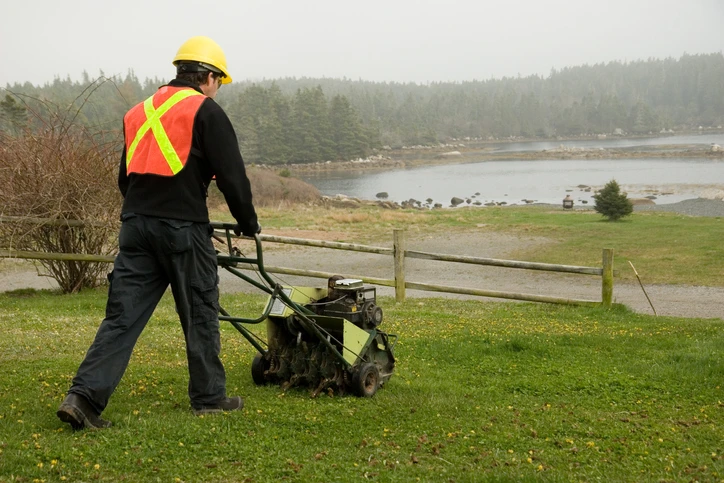5 Aeration Mistakes & The Quick Fixes

“How do I get a vibrant and healthy lawn that makes the neighbors green with envy?” The jealous neighbor part doesn’t usually follow the question, but we know bragging rights are a big deal in close-knit communities like Gettysburg.
Everyone wants and deserves a thriving turf, and aeration and overseeding are some of the most important landscaping tasks to get you there. Of course, you may run into some issues and make mistakes, but our team at The Grounds Guys of Gettysburg wants to help you avoid or fix them.
Mistake 1: Using the Wrong Equipment
All aerators aren’t made equally, and often the best equipment is the simplest. That being said, we don’t expect you to grab a spading fork or a pair of cleats and head outside for some good ole DIY aerating. Technology exists to make our lives easier, and we recommend utilizing it.
The Fix: Research the Proper Tools
Aerating involves more than just making holes in the ground. If it were as simple as that, aerating wouldn’t require much thought. A core aerator is one of the best tools for straightforward aeration that removes soil plugs and creates 2-3 inch deep holes for turf seeds to germinate.
Mistake 2: Aerating at the Wrong Time/Season
There’s a misconception that every day is a good day for aeration. Unfortunately, this kind of thinking will have you working hard with very little positive impact. Is there truly a good time to aerate? Yes! Aerating and overseeding too late in winter exposes your soil and plant roots to frigid environments. But aerating too early during the height of summer can result in shallow roots that don’t attach or seeds that don’t germinate.
The Fix: Aerate in September
Aeration must be done in September in Gettysburg because it’s not too hot or too cool during this time. You have perfectly moderate temperatures that produce cool air and moist soil, ideal for aerating. These conditions also help fortify your turf and build a resistance to soil drought, leaf disease, and invading insects.
Mistake 3: Mowing Too Soon
There’s a natural urge to mow your grass when you notice it’s becoming unruly. Normally, we would suggest mowing your grass to deter pesky insects and allow sunlight to penetrate the soil. However, if you mow soon after aerating, you could be doing more harm than good.
The Fix: Wait 2-4 Weeks Before Mowing
Depending on the type of grass you have, you’ll want to wait 2-4 weeks before mowing. Specific turf like Kentucky bluegrass should be mowed 4 weeks after aeration, while fescue and ryegrass require a 10-14 day waiting period before mowing. Additionally, you don’t want to mow too closely to the turf.
Ensure your mower blade maintains a height of:
- 1-2.5 inches for rough bluegrass
- 2-2.5 inches for Kentucky bluegrass
- 2-3 inches for ryegrass
- 3-4 inches for fescue grass
Mistake 4: Applying Weed Control Too Soon
One of the worst things to happen after aerating is weeds upending all the hard work you’ve put into your lawn. Weed control is vital in lawn care and maintenance, but applying chemically enhanced or organic weed control too soon can have negative long-term effects, including:
- Putting stress on young seedlings
- Weakening plant roots
- Burning or damaging grass sprouts
The Fix: Mow Several Times Before Controlling Weeds
Weed control is a must, but not at the expense of your freshly aerated lawn. Wait until after you’ve mowed at least five times before applying weed control solutions. This kind of patience will give your young plants time to grow stronger root systems and flourish after weeding.
Mistake 5: Not Knowing the Type of Grass You Have
Most homeowners are more concerned about how the lawn looks and how healthy it is than trying to understand the type of grass they have. Standard products on the market help enhance your soil and ensure your grass grows. However, there are times when knowing the kind of grass you have can aid in proper maintenance.
The Fix: Get to Know Your Grass Genus
In Gettysburg, you’ll typically find Kentucky bluegrass, perennial ryegrass, fine fescues, and rough bluegrass. These cool-season grasses are durable, moderately heat and drought-tolerant, and recover fairly quickly after dormancy. Understanding these turfgrasses will help you know when and how to aerate and overseed to give them the best chance to survive and thrive.
Made a Few Aerating & Overseeding Mistakes? Hire the Right Guys to Help!
Mistakes will happen. Unfortunately, mistakes when it comes to lawn care and maintenance can mean unhealthy turf that requires a lot of attention to bring it back to life or sod installation to start over again. At The Grounds Guys of Gettysburg, it’s our mission to see that your lawn prospers through all seasons with a regular maintenance routine and various lawn care services you can always count on.


